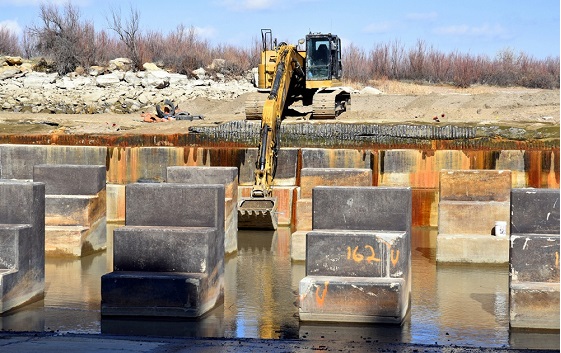A 12-person multi-disciplinary team of engineers from the U.S. Army Corps of Engineers, Albuquerque District recently found the concrete of John Martin Dam’s stilling basin to be in good condition during an inspection.1
The concrete stilling basin sits immediately downstream of the concrete dam and contains nearly 200 8-foot (2.4 m) tall concrete baffle blocks, which dissipate the energy of water that is released from 16 massive tainter gates. Without this important feature, the water released by the tainter gates could undermine the dam’s foundation.
“The inspection found very little damage in the stilling basin. In fact, some areas of concrete looked nearly new,” said Tracy Aragon, civil engineer in the Albuquerque District’s operations support branch and inspection team lead.
The inspection team was primarily looking for damage in the concrete that would expose the reinforcing steel to corrosion and offset in the joints that would indicate instability of the structure. “The results of the inspection showed that the structure is performing as designed and also exposed a few additional unanticipated concerns, which the engineering team was able to correct before the contract was complete,” Aragon said. “The biggest surprise of the inspection was that the 2,000 plus drain holes in the stilling basin floor were partially clogged. These drains were cleaned before refilling the stilling basin.”

Drain holes serve to relieve water pressure from underneath the concrete of the stilling basin floor, Aragon explained. “In every dam, some water ‘leaks’ through the foundation and under the dam,” she said. “If we trap this water, it can create a buoyant force underneath the dam that could destabilize it. The drain holes need to be kept clear to relieve the pressure under the dam from this leakage water.”
John Martin Dam is a gravity dam, consisting of a concrete middle section and two earthen wing dams on either end. It was originally completed in 1948. The concrete section contains the 16 tainter gates at the top of the dam and six service gates near the bottom. The service gates control most of the water released into the stilling basin and, ultimately, control the flows downstream on the Arkansas River. The 64-foot (19.5 m) tall and 30-foot (9.1 m) wide tainter gates are used during flood control releases.
To ensure the stilling basin performs as expected during flood releases, U.S. Army Corps of Engineers (USACE) regulations recommend inspecting a dam’s stilling basin every 10 to 25 years, depending on the dam. After several years of including this project in the budget request, the U.S. Congress authorized and appropriated funding for this project in fiscal year 2018.
At John Martin, the concrete of the stilling basin has been underwater since it was completed more than 75 years ago. In addition to removing the water, approximately 55,000 yd3 (42,050.5 m3) of sediment that had built up from regular conduit releases over the years also had to be removed to inspect the concrete.
According to the investigation report, the baffle block concrete is in good condition overall. The majority of the baffle blocks appeared to have been covered with sediment, which reduced the possibility of damage from erosion or abrasive water flows.
The dewatering portion of the $4.8-million project began Nov. 1, 2018, with the contract awarded to engineering, environmental, and construction firm McMillen Jacobs Associates. In this phase, the contractor installed six high-powered pumps in the stilling basin, which began the process of removing the basin’s water. Due to the high nutrient content of water in the stilling basin, the area had become a high quality, well-known “honey hole” for local anglers. In fact, the stilling basin has produced multiple state record bass and catfish, according to USACE officials.

Project staffers teamed up with local Colorado Parks and Wildlife (CPW) staff and volunteers to relocate game fish from the stilling basin to the main body of the reservoir. The fish were collected through various means, including electrofishing, seine-netting, and dip-netting. Upon breaching the surface, USACE and CPW employees captured the fish via dip-net and placed them in an oxygenated holding tank on the boat. Once the holding tank was full, the fish were transferred by hand to a hatchery truck, which shuttled the fish up and over the dam to the main body of the reservoir — where they were released into the lake.
With most of the water and fish out of the way, crews were able to begin hauling sediment out of the stilling basin. Backhoes, skid-steers, excavators, and dump trucks worked to move the water-saturated dirt from the stilling basin to a settling area to dry out. Once dried out, the sediment was used to improve the grade of one of John Martin’s numerous food plots to make irrigation easier and more effective. Once the sediment was removed, the inspection of the concrete could begin.
“The project delivery team did an outstanding job designing and monitoring the construction to completion,” said Felton Prosper, project manager in the civil project management branch of USACE’s Albuquerque District. “The project was constructed on time, [with] no fatalities, and within budget.”
Source: U.S. Defense Video Imagery Distribution System, www.dvidshub.net.

Reference
1 “John Martin Dam’s Concrete Stilling Basin in Excellent Condition After First Inspection in More Than 75 Years,” Defense Visual Information Distribution Service News, Oct. 18, 2019, https://www.dvidshub.net/news/348292/john-martin-dams-concrete-stilling-basin-excellent-condition-after-first-inspection-more-than-75-years (Sept. 14, 2020).
This article was originally published in the Fall 2020 issue of WaterCorr. Republished with permission.